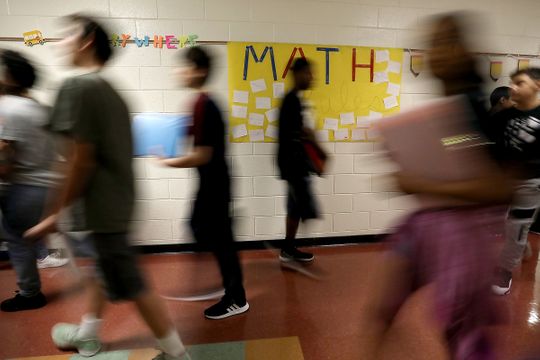Back to School Coming Earlier for More Michigan Students
By David Jesse
It was two days into the 2018-19 school year — a jarring early start for the kids at Wilkinson Middle School in Madison Heights — and Tynae Ward was still adjusting. "It was such a short summer," said Tynae, an eighth-grader whose school year began a week ago. So short, in fact, that she wasn't fully ready to give up sleeping in and staying awake late into the evening — and early morning. "The next thing you know, we had to go back on a schedule. You have to adjust … to getting back into the process of school." An unprecedented number of school districts and charter schools in Michigan are shortening their summers — some by just a few days but others by a few weeks — and starting the school year before Labor Day. The earlier starts are giving those districts more flexibility, but it's upsetting tourism officials who say August is a big month for their industry and when schools start early, it limits family vacation plans — thus cutting into tourism revenue. "The season is already a short season," said Nicki Polan, executive director of the Michigan Boating Industries Association. "To shorten it doesn't do anyone any service." Eastpointe Community Schools is starting Aug. 28. So is Fenton Area Public Schools. In Dearborn Public Schools, the school year starts Aug. 27. Two elementary schools in Kalamazoo Public Schools have already begun the school year. And in Madison District Public Schools, elementary and middle school students began the school year on Aug. 7. These school districts are bypassing a law passed in 2005 that mandates the first day of school not be held until after Labor Day. This year, that means the earliest school will start for most kids is Sept. 4. The law, however, allows school districts to apply for waivers from the Michigan Department of Education.
The number of waivers has grown from 26 for the 2012-13 school year to about 150 for the upcoming school year. Last year, there were 123 waivers. There is an unknown number of additional schools starting early than what's on the official list provided by the MDE. Intermediate school districts — agencies that provide a range of services for school districts within their boundaries — can also apply for waivers that can be used by any of their local districts. The state doesn't track those districts. But the potential is for far more districts and schools to start early without seeking state approval. Oakland Schools — the ISD for 28 Oakland County school districts — received a waiver that was effective for the 2017-18 school year. Five school districts — Clarkston, Madison Heights, Southfield, Troy and Walled Lake — use the ISD waiver, said Carolyn Claerhout, manager of pupil, corporate and district services at the ISD. Another two Oakland districts — Oak Park and Oxford — have their own waivers. So why are more districts seeking waivers? There are a number of factors, including a desire by more districts to shorten the long summer break, when students tend to lose what they've learned. Others are starting early in order to fit in a growing number of instructional days. Meanwhile, some districts have sought waivers for early/middle college programs, which typically partner with a nearby community college. The early start allows those programs — where students can receive a high school diploma and an associate's degree in five years — to operate on the same calendar as the college. Balancing the calendar, stemming summer loss In the Madison Heights district, the elementary school moved to an early start beginning with the 2015-16 school year. The middle school students joined them this year. For Wilkinson Principal Angel Abdulahad, the early start meant less time to get the building ready, and has been an adjustment for students and staff. But he sees big benefits. The two schools in the district use what's called a "balanced" calendar. So, they start the school year early, but have more breaks throughout the school year. For instance, on Oct. 22, they begin a two-week break. Their spring break will be two weeks. And they still have the other traditional breaks: Thanksgiving, Christmas and midwinter. The school year ends June 20. A shorter summer, he said, means teachers don't have to spend as much time re-teaching material at the beginning of the school year. It also means more time to teach new material. And the more frequent breaks during the school year? It gives students a chance to recharge. "Basically, we try to do 10 weeks on, two weeks off," Abdulahad said. "What we're hoping is you can go 100% full throttle, then break, reset, relax and be ready to go again — because (otherwise) they're burned out by the end of the year."
During those breaks, the school will operate academic and enrichment camps that will allow kids to catch up if they're behind or struggling. "If the kids are starting to slip, we can provide real-time triage and we can fix it and adjust without losing any real instruction time," he said. Tynae and seventh-grader Brooklyn Rivard, 12, have a healthy list of things they could be doing if they had another month of summer break — like visiting amusement parks and sleeping in. But ask them about any advantages to starting early and the best they came up with is having the longer breaks. "That's nice," Brooklyn said. "My sister is at the elementary school and they had longer breaks and she would always say, 'Ha ha, I have a longer break than you.' " Fitting in 180 days An early start in Dearborn Public Schools is helping the district fit in the 180 days of instruction that are required by state law. The 180-day rule actually kicked in for the 2016-17 school year. But districts like Dearborn — that had existing contracts that established a calendar already at that time — were allowed to wait until those contracts expired. Last year, the Dearborn district provided 175 days of instruction. Adding in those days, while also accommodating things like professional development days and the Eid-al-Fitr holiday for the district's large Muslim population, were a challenge. "You either start early or you're going to be going to school until mid-July," Mustonen. But for as many parents who were pleased with the change, there were others who were critics. "Anytime there's change, you're going to get some feedback," Mustonen said. "For the most part, people understand." Attendance concerns prompt early start The decision to start early in Eastpointe Community Schools came in part because of attendance data that showed that when the district had half-days of school for students — there were eight such days in last year's calendar — large numbers of students didn't show up for school. The state requires 75% attendance in order for a district to receive state aid for that day. On three of the days last year, the district's attendance fell below that mark, Superintendent Ryan McLeod said. The number of half days was cut to four days in the 2018-19 calendar. In order to accommodate more full days of instruction, a school year that extends to 182 days, plus add in a full two-week break during the Christmas and New Year's holidays, the district decided to seek a waiver. Attendance concerns were also behind the decision to go to a full two-week break for the holidays, McLeod said. Last year, for instance, when students returned from the holiday break in the middle of the week, "we had very poor attendance on those days." "There was some concern about why we're doing this," McLeod said "We've had to help people understand why we ended up moving the start date. Usually, once people hear, they understand. Nobody has a desire to go later into June." Put the brakes on waivers, tourism backers say Probably the biggest critics of pre-Labor Day starts are those who represent Michigan's tourism industry. They lobbied for the post-Labor Day start rule in the first place, and want to see the state stop issuing waivers. "The hotels Up North, golf, camping — any outdoor, summer activity — is affected if the schools start early," Polan said. "People stop vacations. They put their boats away. When the boats are put away, the revenue stops for many businesses." Polen noted that surveys found there is strong support for post-Labor Day starts among Michigan residents. A 2016 report from Anderson Economic Group — commissioned by the Michigan Lodging and Tourism Association — found that the post-Labor Day law led to increased tourism and benefited industries that rely on tourism. The early starts, she said, "are going against the economy, businesses and jobs, and against the people's wishes." Contact Lori Higgins: 313-222-6651, lhiggins@freepress.com or @LoriAHiggins
|
.
Any original material on these pages is copyright © BishopAccountability.org 2004. Reproduce freely with attribution.


